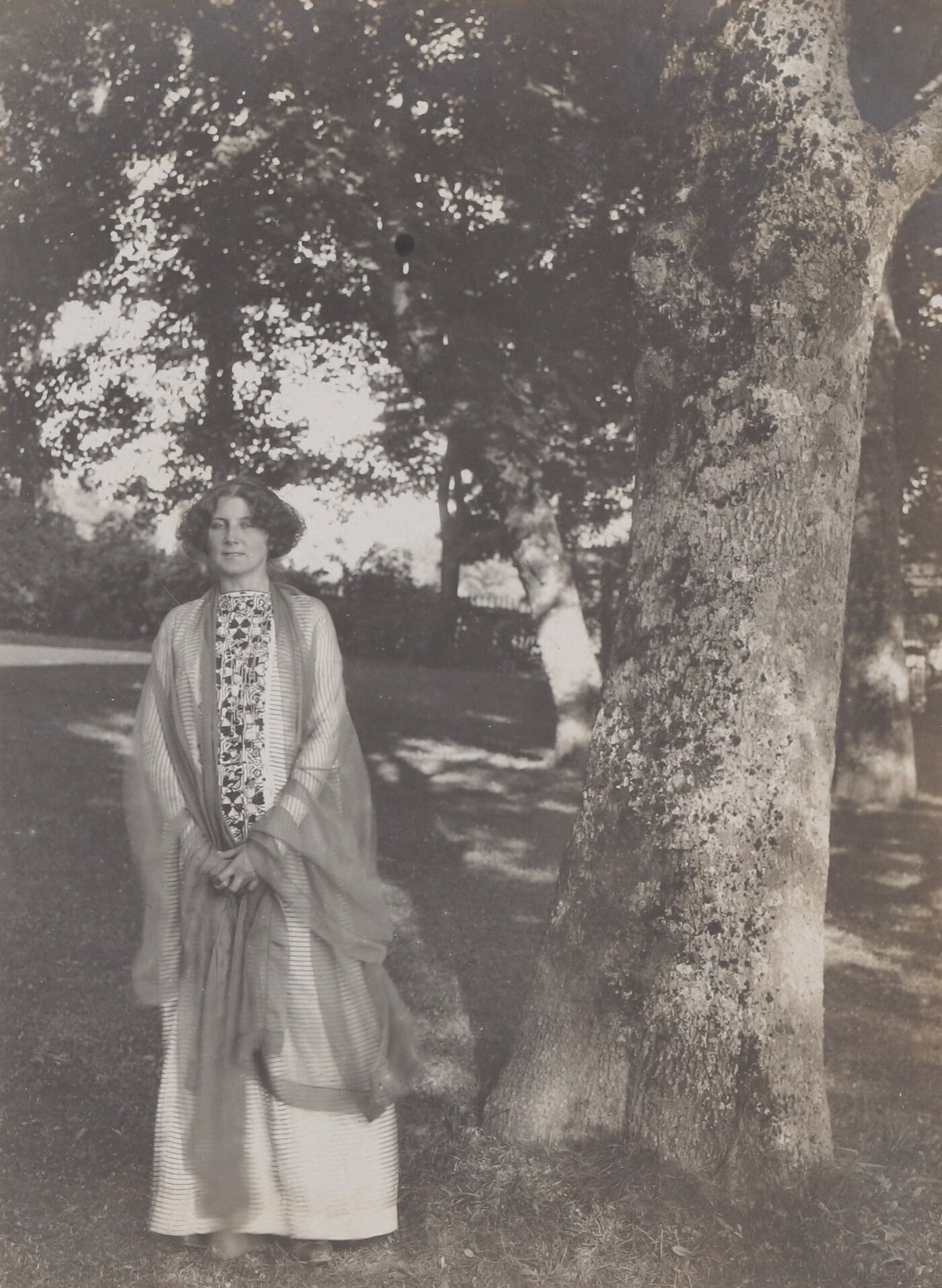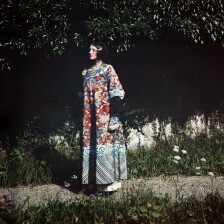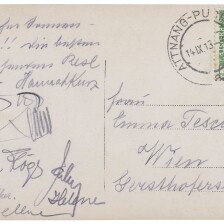Friedrich Gerhard Walker

Friedrich Gerhard Walker in the garden of Villa Paulick, 14.09.1913, Collection Villa Paulick, courtesy Klimt Foundation
© Klimt Foundation, Vienna
The general manager of the Vienna luxury leather ware workshop, Friedrich Gerhard Walker, was a keen amateur photographer and a member of the Camera-Club. His photo series of Emilie Flöge and Gustav Klimt, created in 1913, includes the only color photograph of Klimt known today.
Friedrich Gerhard Walker was born on 23 July 1873 in Vienna, the son of Gustav and Aloisia Walker. His father ran a luxury leather ware workshop at Schottenfeldgasse 11, while his mother owned an apartment building at Feldkellergasse 20, where the family lived. From 1902, Friedrich Gerhard Walker took over as general manager of the company Walker G. & Co, “manufacturers of luxury leather ware,” which he ran together with his brothers Rudolf Georg and Richard Candidus Walker.
Owing to his friendship with Emilie Flöge and Gustav Klimt, Walker was among the guests of Villa Paulick in Seewalchen on the Attersee, where he photographed them on 14 September 1913. He created the only known color photograph of Gustav Klimt, which, owing to a caption in a photo album, an entry by Walker in the guestbook of Villa Paulick and Klimt’s verifiable stay on the Attersee at the time, can be dated precisely.
The amateur photographer Walker conceptualized each of the three photographs as single pictures, in keeping with the strict documentary style commonly used for fashion photographs in the periodicals of the time: Flöge wore a gaily patterned gown, known as a “dragon robe,” as well as a dress with a green chiffon scarf, while Klimt was clad in his blue painter’s smock. Walker used the “Autochrome Lumière color mosaic screen process,” sold by the Lumière brothers from 1907, which, according to its own advertisements, allowed photographers for the first time to capture the world “in natural colors” with only a single exposure. For this expensive method to work, the photographs needed to be taken outdoors, as it necessitated bright sunlight. Walker positioned Flöge and Klimt in the garden and the environs of Villa Paulick. The rather stiff poses of the models and the underexposed photograph of Flöge in the dragon robe illustrate that the exposure time of this novel technique on Lumière autochrome plates was very long and difficult to calculate. The series also includes black-and-white photographs showing Emilie Flöge wearing the same dresses.
It is likely that Flöge, Klimt and Walker had seen similar color photographs already at the studio of Heinrich Kühn, who was among the few photographers to use this complicated and expensive technique. At the time, it was mostly members of the bourgeoisie and nobility who were able to afford photography as a pastime. Several photographers banded together in the elite Vienna Camera-Club, whose members included Kühn and Friedrich Gerhard Walker.
In 1919, Walker married Marianne Gabler. The couple had two sons, Friedrich and Gerhard. He died on 26 August 1934 in Vienna, and was laid to rest in the family tomb at Lainz cemetery.
Literature and sources
- Agnes Husslein-Arco, Alfred Weidinger (Hg.): Klimt & Emilie Flöge. Fotografien, Vienna 2012, S. 234.
- Sandra Tretter, Peter Weinhäupl (Hg.): Gustav Klimt. Sommerfrische am Attersee 1900-1916, Vienna 2015, S. 60.
- Uwe Schögl: Emilie Flöge in zeitgenössischen Fotografien, in: Sandra Tretter, Peter Weinhäupl (Hg.): Gustav Klimt. Emilie Flöge. Reform der Mode. Inspiration der Kunst, Vienna 2016, S. 43-55.
- Parte für Friedrich Gerhard Walker, 27.08.1934, .
- N. N.: Personalnachrichten, in: Neues Wiener Tagblatt, 30.11.1919, S. 7.
- N. N.: Mitgliederverzeichnis. Geschlossen am 15. Juni 1914, in: Wiener Camera-Club (Hg.): Jahrbuch des Camera-Clubs in Wien, Vienna 1914, S. 9-18.
- Fotopostkarte von Therese Flöge am Attersee an Emma Teschner in Wien, mitunterschrieben von Gustav Klimt, Emilie und Pauline Flöge, Helene Klimt jun. und Helene Klimt sen., Josef Eibl, Hannah Kurz und Friedrich Gerhard Walker, LGM 18/47 (14.09.1913), .
- N. N.: 14.09.1913, in: Gästebuch der Villa Paulick. 1881–1947, , S. 92.
- Taufbuch 1873 (Tomus TFB26), Pfarrgemeinde Wien Innere Stadt (Lutherische Stadtkirche), 453. Eintrag.
- N. N.: Wer hat es geschrieben?, in: Neuigkeits-Welt-Blatt, 30.11.1900, S. 14.
- N. N.: Firma-Protokollierungen, in: Wiener Zeitung, 02.03.1901, S. 25.
- Adolph Lehmann's allgemeiner Wohnungs-Anzeiger. Nebst Handels- u. Gewerbe-Adressbuch für d. k. k. Reichshaupt- u. Residenzstadt Wien u. Umgebung, 44. Jg., Band 1 (1902), S. 851, S. 1313.
- Wiener Stadt- und Landesarchiv. Handelsregister Ges 52/194, Signatur 2.3.3.B75.52.194, G. Walker & Co. www.wien.gv.at/actaproweb2/benutzung/archive.xhtml (06/29/2021).

















